Introduction to the Ten Mahavidyas or the Ten Goddesses of Wisdom of Hinduism
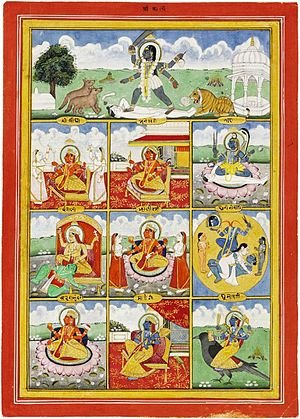
Until the development of the Das Mahavidyas or the ten Mahavidyas, male gods were given much importance and were the focal deities of worship and reverence in Hinduism. It was with the origin of the Ten Mahavidyas that femininity and female gods were seen as the ultimate reality and as guidance toward spiritual awakening and consciousness. The Das Mahavidyas is a Sanskrit word which literally translates as ten Goddesses of great wisdom or great knowledge. These ten goddesses represent the dynamic and multifaceted nature of the divine feminine principle, embodying various aspects of creation, preservation, and destruction. Each Mahavidya is celebrated and worshiped as a manifestation of the Supreme Goddess Devi, and they collectively symbolize the cosmic forces that govern the universe.
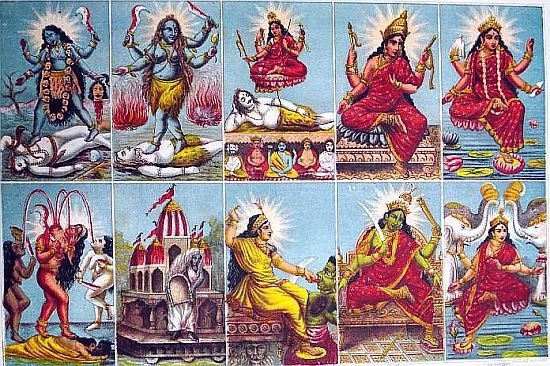
The Mahavidyas emerged within the context of Shakta tradition, which worships the divine feminine as the supreme reality. This tradition is rooted in the worship of Devi, the Great Goddess in her various forms and is significant to the ten goddesses who incorporate various aspects of Shakti’s power and wisdom. The Mahavidyas first appeared in the medieval period, with significant textual references found in the Shakta Agamas, Tantras, and Puranas. The Devi Bhagavata Purana and the Mahabhagavata Purana as well offer detailed accounts of the Mahavidyas.
The origin of the ten Mahavidyas has multiple narrations in Hinduism. One such narration tells the playful quarrel between Shiva and Parvati. It begins with Shiva and Parvati engaging in one of their playful exchanges, which escalates into a serious disagreement. Shiva, in a moment of frustration and consumed by anger threatens to leave Parvati. Despite Parvati’s efforts to reconcile, Shiva remains adamant. In response to Shiva’s threat, Parvati demonstrates her divine power and inventiveness by multiplying herself into ten different avatar or forms, each representing the direction Shiva escapes to. This symbolism of Parvati’s ten manifestations for each direction portrays her omnipresence and omnipotence, signifying that no matter where Shiva goes; in the end he will encounter Parvati in one form or the other.
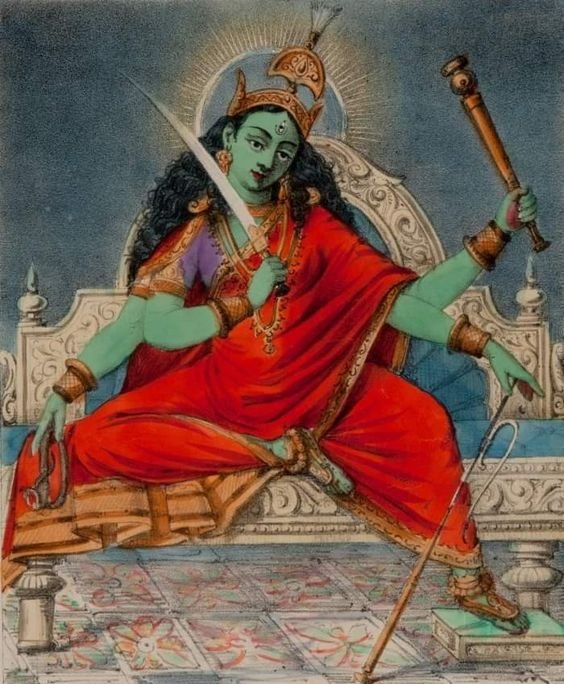
During his escapade, as Shiva encounters each of Parvati’s manifestations, he undergoes a transformative spiritual journey. Each Mahavidya represents a unique aspect of the divine feminine, revealing essential truths about love, devotion, and cosmic harmony to Shiva. Through these encounters with the ten Mahavidyas, Shiva comes to realize the eternal nature of their love and the inherent superiority of the Goddess over her male counterpart. Shiva’s acceptance and spiritual awakening in the face of Parvati’s manifestations symbolize the harmonious balance between masculine and feminine energies within the universe. This narration of the origin of the Mahavidya’s also highlight the role of the Goddess as a spiritual guide and muse, leading devotees towards enlightenment and as embodiments of divine wisdom they inspire the seekers towards the truths about existence and consciousness.
In another narration it is said that Sati the first wife of Lord Shiva, felt misunderstood and as a result of it had multiplied herself into ten forms. Sati was the daughter of Daksha Prajapati and consort of Shiva. She had defied her father’s wishes by marrying Shiva and in his vanity; Daksha had organized a yajna or sacrifice in order to insult Shiva by inviting all the gods and goddesses except for Shiva. Sati learning of this from Narad Muni, sought Shiva’s permission to attend, arguing that a daughter didn’t need a formal invitation. However, Shiva, aware of Daksha’s intentions, advised against it, warning of the inauspicious outcome. At this Sati felt misunderstood and disregarded by Shiva, and manifested her divine power by transforming into the Divine Mother. Her presence caused upheaval in nature, forcing Shiva to escape her fury. Yet Sati, in her multiple divine forms stood on every direction and prevented Shiva from escaping.
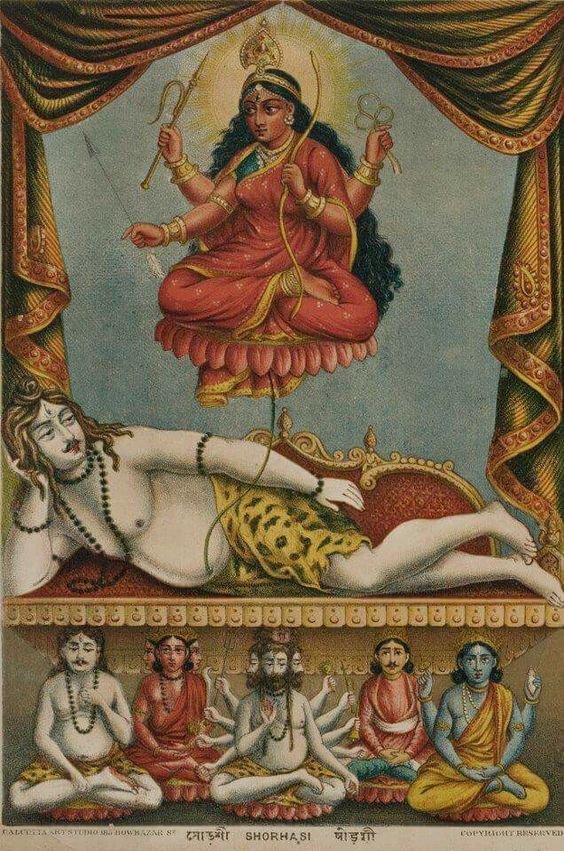
The ten Mahavidyas namely: Kali, Tara, Tripura Sundari, Bhuvaneshwari, Chinnamasta, Bhairavi, Dhumavati, Bagalamukhi, Matangi, and Kamala, are considered to be a group of tantric goddess. Tantra is an esoteric tradition followed by a small number of devotees which includes emphasis on rituals, mantras, yantras and the worship of divine energies to achieve spiritual liberation and worldly benefits. The ten Mahavidyas occupy a central place in tantric practices due to their association with great spiritual wisdom and knowledge and their ability to bestow various siddhis and powers upon their devotees.
Kali, is often regarded as the most fearsome and powerful of the Mahavidyas. She represents the tantric and ultimate reality, time and change. She is worshipped in tantra for her power to destroy ignorance and liberate the soul from the cycle of birth and death. Tara, known as the saviour and protector guides her devotees through the turbulent waters of existence. Tantric rituals of Tara focus on invoking her compassion and protection. Tripura Sundari, also known by names of Shodashi or Lalita, represents the beauty of the three worlds. Her worship is central to the Sri Vidya tradition of tantra which involves rituals and use of the Sri Yantra. Bhuvaneshwari, is the goddess of the cosmos and her worship mainly involves recognizing the divine presence in all creation. Tantric practices dedicated to her emphasize visualization, meditation, and rituals that honour the interconnectedness of all life.
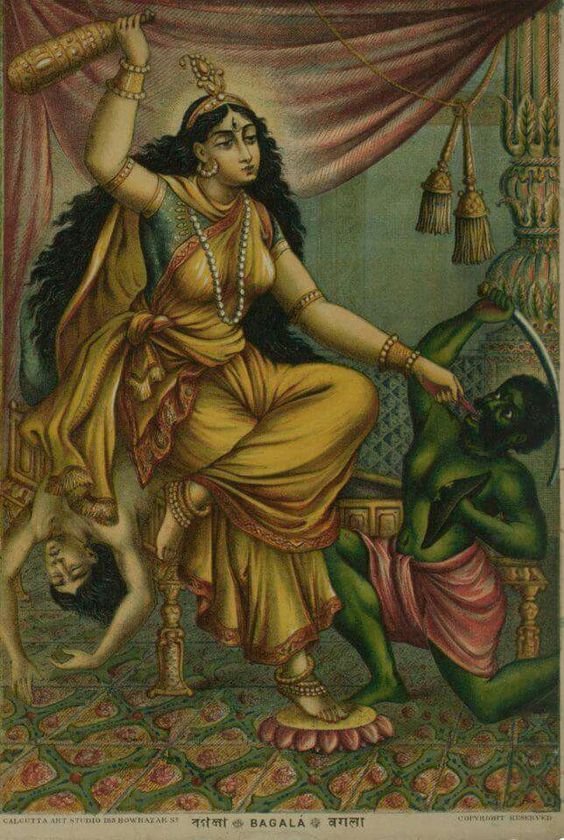
Chinnamasta, is often portrayed as a decapitated figure, holding her severed head in one hand while streams of blood flow from her neck into her mouth and those of her attendants. Tantric practices of Chinnamasta involve confronting fear and attachment, often through intense and challenging rituals and mantras. Bhairavi is a goddess that represents fierceness and terrifying aspects. She is often associated with the transformative power of destruction. Her worship in tantra involves rituals that focus on inner purification, protection, and the harnessing of inner strength. Dhumavati is the wisdow goddess and embodies inauspiciousness and the void. Tantric rituals dedicated to this goddess include meditation on her form and invoking her to dispel ignorance and worldly illusions.
Bagalamukhi is known for her power to paralyze and silence. Her tantric practices involve mantras and rituals designed to neutralize negative forces and to gain control over speech and perception. Matangi is the goddess of inner knowledge and speech. She is associated with music, learning and arts. Tantric practices of this particular goddess often involve the use of her mantras to enhance communication skills, wisdom, and creative expression. Lastly, Kama is the tantric form of Goddess Lakshmi. She is associated with wealth, prosperity and fertility. Her tantric form of worship involves rituals that attract abundance and remove poverty.
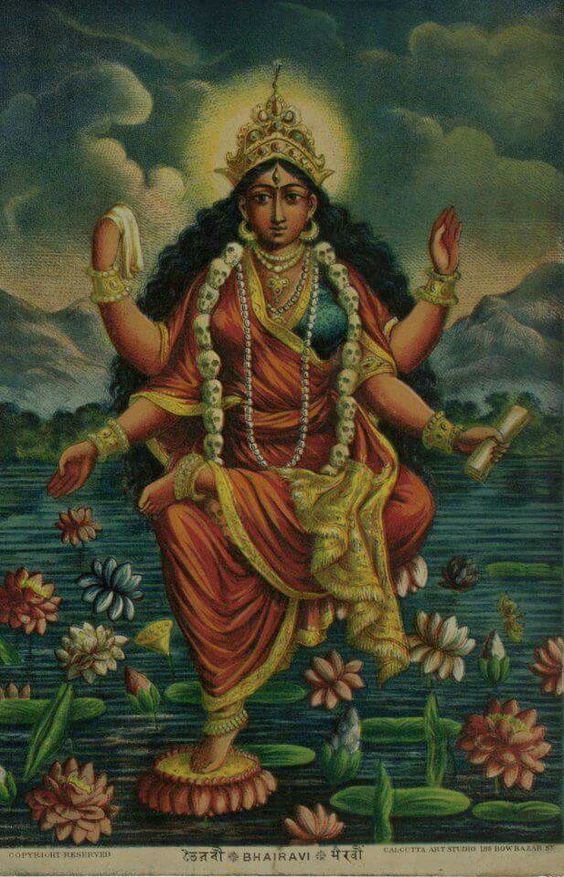
The Mahavidyas, combined together represent the divine feminine, encompassing creation, preservation, destruction, and transcendence. They challenge the ideas of conventional divinity by having both kind temperament and terrifying qualities to them, portraying interconnectedness and holistic outlook on the cosmos. In tantric tradition, each of the ten goddesses of great wisdom serves as a door to different levels of consciousness and spiritual state of a devotee and spiritual seeker. Their worship is not only limited to their praises but is also about inheriting their qualities and achieving spiritual transformation.
The concept of Mahavidyas in Hinduism is a representation of spiritual guidance and wisdom within the larger tradition of Shakta worship. The ten goddesses that make up the group possess powers of divine feminine that make clear pathways for the devotees of the goddess to seek spiritual growth, transformation and consciousness. These divine feminine balance out the energies between masculine and feminine energies, and emphasize the role of the divine feminine within the cosmos. Through the worship of these ten goddesses the devotees of the religion or the particular tradition engage in rituals, meditations, chanting of mantras in order to come to the ultimate realisation of the unity of all existence and consciousness. These goddesses bring together the forces of masculinity and femininity.


